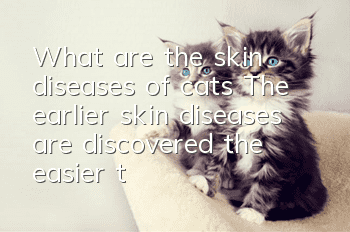What are the skin diseases of cats? The earlier skin diseases are discovered, the easier they are to control.

In addition to their own factors, cats may also have some external causes of skin disease. Cat skin disease is a relatively common disease. If it is discovered and treated early, cat skin disease is relatively easy to cure. . So what are the skin diseases of cats? Let’s briefly analyze them for you.
Common skin diseases in cats include bacterial skin diseases, immune abnormal skin diseases, metabolic skin diseases, ectoparasitic skin diseases and fungal skin diseases.
Bacterial skin diseases: mainly bacterial infections; immune abnormality skin diseases: nutrition-related skin diseases, etc. Metabolic dermatoses: hormonal dermatoses; allergic dermatoses; ectoparasitic dermatoses: caused by fleas, demodex, scabies mites, lice, ear mites, ticks, etc.;
Fungal skin disease: caused by fungal infection; skin fungi survive for a long time in nature, have strong resistance, and can survive for more than 1 year in a dry environment. There are also some fungi that have an affinity for soil and can grow and reproduce in the soil and survive for a long time. Fungal skin diseases are the most common form of cat skin, accounting for more than 80% of cases. Among them, 98% are caused by Microsporum canis. This type of skin disease can be infected with each other in dogs, cats, and humans. Special attention is required.
Three common skin diseases in kittens
1. Flea allergy dermatitis: As the name suggests, it is caused by small red papules appearing in the wound after a flea bite. The wound appears after the cat scratches it due to itching. Sometimes the wound will be combined with mold and bacterial infection, making the lesion area The more it expands, the bigger it gets.
2. Scabies: This is a type of scabies that first parasitizes in the ears, then attacks the head, and then the whole body. When this insect eats animal dander tissue, it will cause severe itching, so when If you find that the kitten keeps scratching its ears and shaking its head, you should pay attention. It may even have scabs, ulcers, pustules... Please stop "observing" and send it to the hospital for treatment!
3. Ringworm: Cats under one year old are easily infected with ringworm, which is a special kind of mold. The typical symptoms are irregular round hair loss areas, mixed with scaly spots and scars, and sometimes allergies. Sexual papules, this kind of ringworm is highly contagious and common to humans and animals. Once discovered, it must be treated and controlled as soon as possible.
If the kitten has suffered from skin diseases, its related utensils should be thoroughly disinfected, and the surface should be scrubbed or sprayed with 0.5% bleach. If the kitten is exposed to sunlight for 5 to 6 hours a day for one week, the effect will be seen. It will be better, it is best to expose it to the sun until the cat recovers from treatment. Since mold will survive in the form of spores, after the cat treatment is effective, it will continue for about one week to ten days. The same goes for disinfection of utensils, so as to avoid the chance of recurrence. Otherwise, the remaining mold spores can still survive and lurk for up to 3 days. , 4 years, it’s scary! So once you find that your cat is losing hair,, scratching the skin, etc., be sure to take him to the doctor in time.
- How much does a British Shorthair cat cost per month? Breeding a British Shorthair cat!
- How to tell if your cat has worms?
- What to do if a cow cat vomits?
- Can I smoke in the cat room?
- What causes cats to shake their heads?
- Does cat plague have an incubation period?
- Kitten's eyes bleed with pus
- Why do cats like to drink water from human cups?
- How to correct a cat that always rolls in the litter box?
- What should I do if my cat can’t cough up phlegm?



